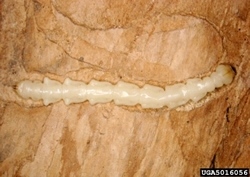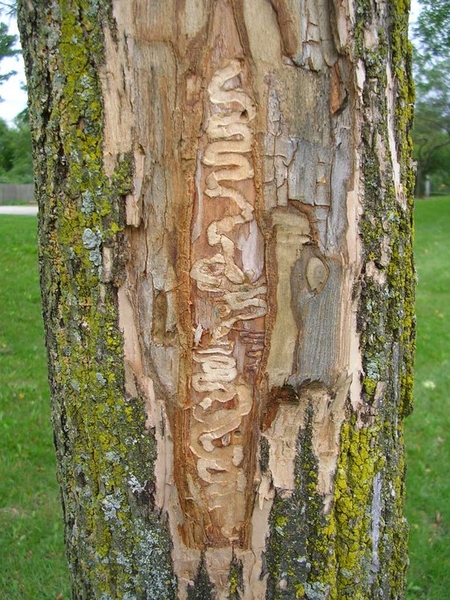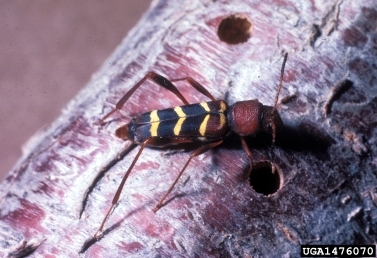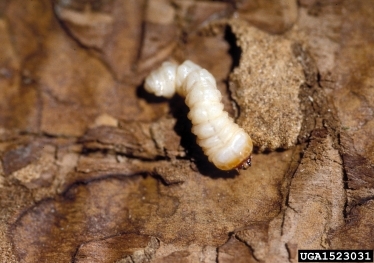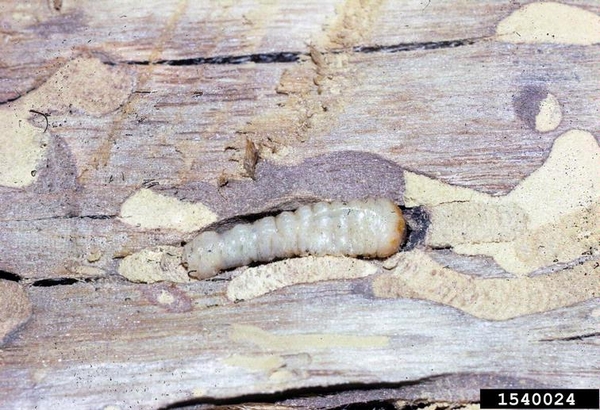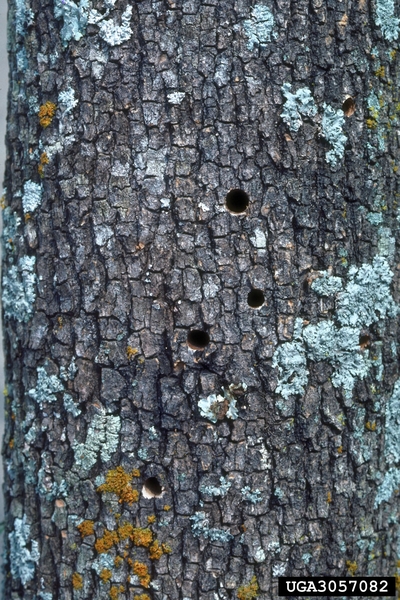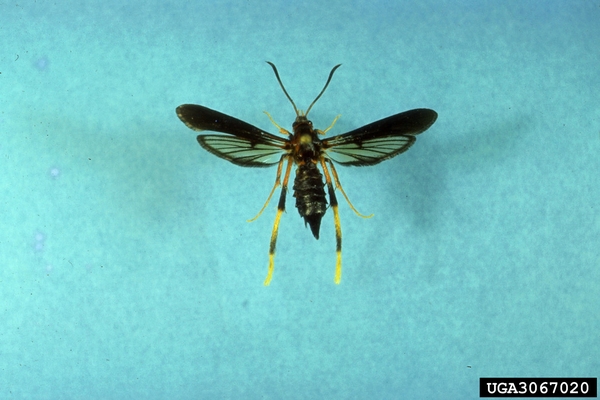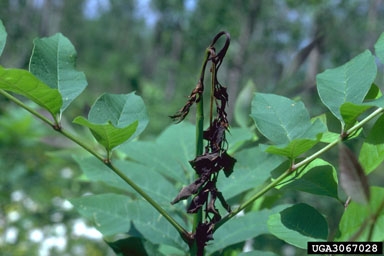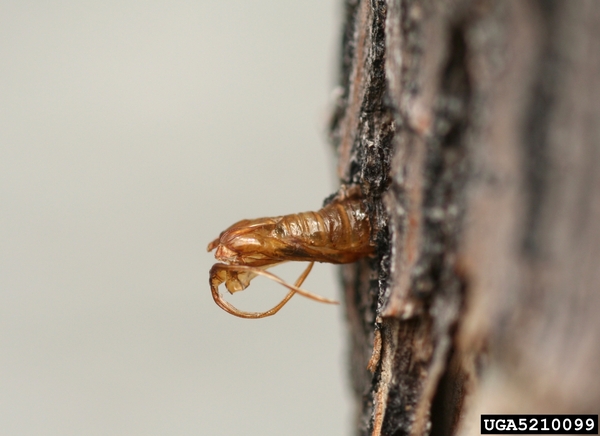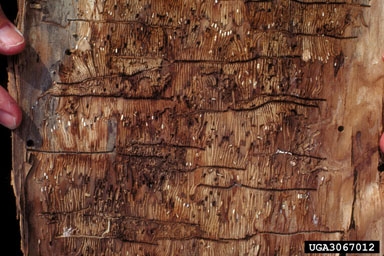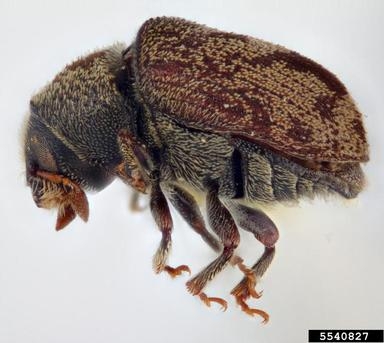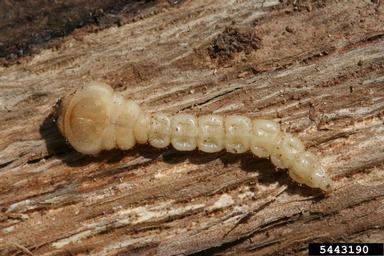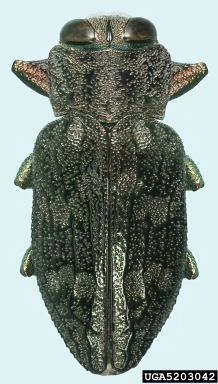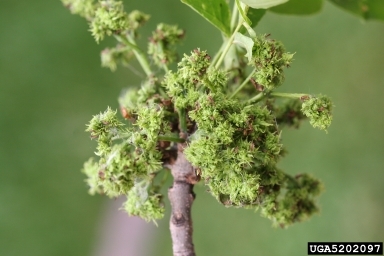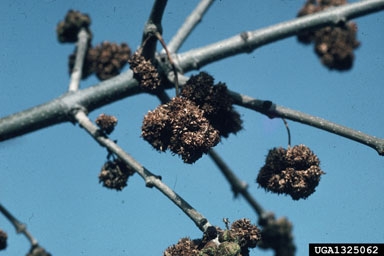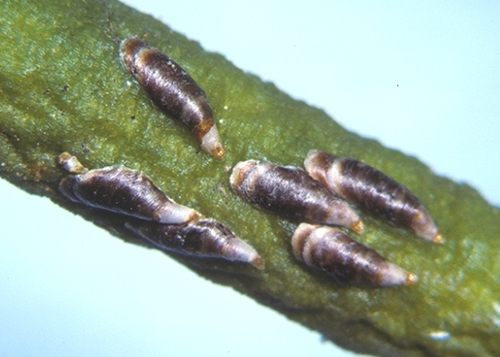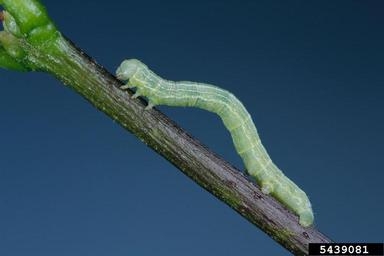Emerald Ash Borer
The emerald ash borer (EAB; Agrilus planipennis) is a devastating pest of all ash species in North Carolina: white ash (Fraxinus americana), green ash (F. pennsylvanica), pumpkin ash (F. profunda), and Carolina ash (F. caroliniana). The insect was introduced from Asia via wood packing materials and was first detected in the U.S in 2002 near Detroit. It has since spread to many states, including North Carolina, where it was detected in 2013. Since its introduction, EAB has killed tens of millions of ash trees. When EAB is introduced to an area, adult beetles will fly to ash trees and lay eggs. The eggs will hatch, and the immature insects will feed in the inner bark (phloem) and outer wood (xylem). This results in a thinning canopy, branch dieback, and epicormic branching from the tree’s trunk. Distinct signs of EAB include D-shaped exit holes (⅛’’ inch) and galleries (serpentine tunnels) under the bark. Trees usually die within five years of infestation, or two years from symptom onset. High-value trees may be treated with insecticides. More information about EAB in North Carolina is available from NC State Extension.

Characteristic D-shaped exit holes are signs of an emerald ash borer infestation.
Kelly Oten CC BY 4.0
Redheaded Ash Borer
The redheaded ash borer (Neoclytus acuminatus) primarily targets newly planted, stressed, and dying trees. They attack several species of dead and dying hardwoods, but appear to favor ash, oak, hickory, hackberry, and persimmon. The larvae as they feed in both the sapwood and heartwood, damaging tranportation tissues beneath the bark, which leads to branch dieback and eventually tree death. The “tunnels” (called galleries) often follow the direction of the wood and are packed with insect frass, or excrement. In young trees, the larvae move both vertically and horizontally through the trunk. Once the redheaded ash borer is inside a tree, there is not a recommended control method. The best method is prevention; keeping trees healthy can prevent infestation altogether. More information about the redheaded ash borer is available from NC State Extension.
Clearwing Borers (Lilac Borer and Banded Ash Clearwing Borer)
The lilac borer (also known as the ash borer; Podosesia syringae) and the banded ash clearwing borer (Podosesia aureocincta) are clearwing moths that infest ash trees. The banded ash clearwing broer attacks ash trees exclusively while the lilac borer also attacks other plants, including lilac (Syringa vulgaris) and privet (Ligustrum). Larvae tunnel into trunks and lower branches of trees and shrubs, causing wounds under the bark. This causes foliage wilting, branch breakage, and swelling/cracking of infested areas due to invasion of the sapwood. Additionally, the wounds create a path of entry for a wood-destroying fungus (Polyporus vericolor) to invade. The borers pupate inside the tree close to the surface and emerge as adults via round exit holes roughly ¼ inch in diameter. It is common to see pupal skins right outside the bark during this phase. The lilac borer emerges as an adult early in the season and the banded ash clearwing borer emerges in the fall or early winter. Control includes destroying infested branches and stems and sometimes insecticides such as permethrin. More information about the lilac/ash borer is available from NC State Extension.
Ash Bark Beetle
The ash bark beetle (Hylesinus spp.) infests stressed and weakened ash trees. Females create tunnels (galleries) in which they deposit eggs in the spring. These galleries are perpendicular to the wood grain of the trunk or branch. Larvae emerge in the summer and tunnel perpendicularly away from the initial egg gallery. These galleries disrupt water and nutrient flow within the tree. Signs of this insect include entrance and exit holes and yellow or brown branches. Maintaining tree health through proper care will both help prevent and reduce the impact of this insect. More information about the ash bark beetle is available from the US Forest Service.
Flatheaded Apple Tree Borer
The flatheaded apple tree borer (Chrysobothris femorata) attacks several deciduous trees, including apple, oak, maple, ash, hawthorn, and dogwood. Weakened and damaged trees are most susceptible. The larvae damage the tree by forming tunnels (galleries) in the cambium tissue and feeding in the phloem and outer sapwood. The metallic adult beetles lay orange/red-brown eggs in bark crevices or under bark scales. The flatheaded apple tree borer is considered a minor pest since it infests stressed or dying trees; however, tproper tree care can help prevent damage. This insect is often confused with emerald ash borer (EAB) due to their similar D-shaped exit holes. Flatheaded apple tree borer exit holes are much larger than EAB exit holes (EAB exit holes are 1/8"). More information about the flatheaded apple tree borer is available from NC State Extension.
Ash Flower Gall Mites
Ash flower gall mites (Eriophyes fraxiniflora) are small, carrot-shaped mites with two pairs of legs. Female mites feed upon and lay eggs in male flowers, causing ½ to 1 inch indiameter galls to form. Galls are lumpy, round, and green and often accompanied by leaf distortion. Though the galls can be unsightly and cause strained branches during large infestations, the damage is generally not serious and does not impact the health of the tree. If treatment is deemed to be necessary, oils or other chemicals may be sprayed shortly before bud break. More information about ash flower gall mites is available from the University of Wisconsin Division of Extension.
Oystershell Scale
Oystershell scale (Lepidosaphes ulmi) is a damaging insect that affects over 125 species of plants, including ash, maple, willow, poplar, and lilac. They are armored scales, with a hard shell (called a "test") covering and protecting the insect. Eggs are laid beneath the test and hatch in early spring. Emerging first-stage nymphs (also referred to as ‘crawlers’) find a place to settle on the bark, where they insert their mouthparts to feed, retrieveing nutrients. Females remain in this postion for the remainder of their lives; males remain in this position until the adult stage, when they emerge as a winged insect and seek out females. Oystershell scales can accumulate in alarming numbers, causing twig and branch dieback. Heavy populations are capable of killing entire trees. Management strategies include pruning out heavily infested branches, physical removal of insects with a scrubber, or insecticides during the crawler stage. More information about oystershell scale is available from NC State Extension.
Cankerworms
Spring cankerworms (Paleacrita vernata) and fall cankerworms (Alsophila pometaria) are abundant defoliators of many species of hardwood trees, including maple, oak, beech, elm, ash, dogwood, and cherry. The female insects emerge in the spring (spring cankerworm) or fall (fall cankerworm) and lay eggs on the twigs in clusters. In the spring, the eggs of both species hatch and young caterpillars skeletonize the leaves, often leaving only the midrib. The caterpillars are sometimes called “inchworms” since they have a gap between their two sets of legs that gives them the appearance of “inching” as they crawl. Depending on the age of the caterpillar, they can be green with pale stripes or green with dark stripes. Adult moths are gray. Females are flightless and must crawl up the tree truck to lay eggs, a behavior that is taken advantage of for management purposes. Management strategies may include banding the trees with sticky material to intercept female trunk ascension and applications of pesticides. In severe infestations, municipalities may spray large areas. More information about spring cankerworms and fall cankerworms is available from NC State Extension.
References
Ash Bark Beetle. (n.d.). USDA Forest Service.
Baker, J. (2018, November 15). Flatheaded Appletree Borer. NC State Extension.
Baker, J. (2013, April 4). Lilac Borer/Ash Clearwing Borer. NC State Extension.
Baker, J. (2017, August 7). Oystershell Scale Insect on Ornamental Plants. NC State Extension.
Baker, J. (2017, September 29). Redheaded Ash Borer. NC State Extension.
Cranshaw, W. S. (2014, May). Lilac/Ash Borer: A Common Wood Borer of Colorado’s Street Trees. Colorado State Extension.
Cranshaw, W. S. (n.d.). Recognizing Wood Boring Insects of Ash Trees in Colorado. Colorado State Extension.
Emerald Ash Borer Beetle. (n.d.). USDA Animal and Plant Health Inspection Service.
Emerald Ash Borer Frequently Asked Questions. (n.d.). NC Forest Service.
Frank, S., Baker, J., & Bambara, S. (2013, March 27). Fall Cankerworm. NC State Extension.
Oten, K. (2020, December 16). Emerald Ash Borer. NC State Extension.
Oystershell Scale. (n.d.). USDA Forest Service.
Pellitteri, P. (2012, August 6). Ash Flower Gall. Wisconsin Horticulture Division of Extension.
Publication date: May 16, 2022
Recommendations for the use of agricultural chemicals are included in this publication as a convenience to the reader. The use of brand names and any mention or listing of commercial products or services in this publication does not imply endorsement by NC State University or N.C. A&T State University nor discrimination against similar products or services not mentioned. Individuals who use agricultural chemicals are responsible for ensuring that the intended use complies with current regulations and conforms to the product label. Be sure to obtain current information about usage regulations and examine a current product label before applying any chemical. For assistance, contact your local N.C. Cooperative Extension county center.
N.C. Cooperative Extension prohibits discrimination and harassment regardless of age, color, disability, family and marital status, gender identity, national origin, political beliefs, race, religion, sex (including pregnancy), sexual orientation and veteran status.


